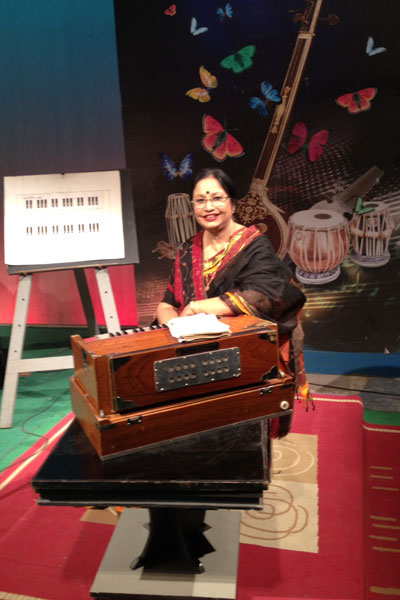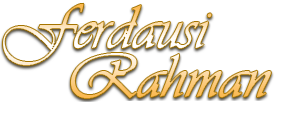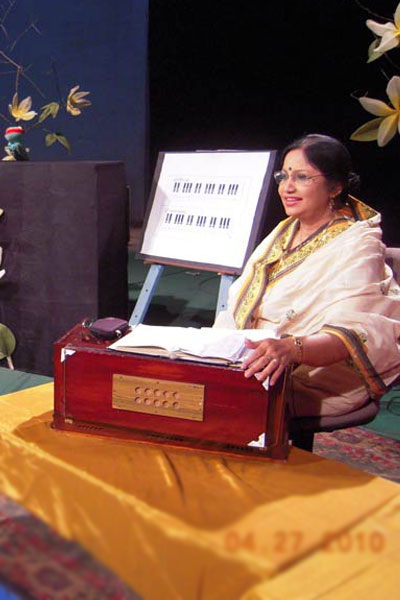Easho Gaan Shikhy

Surprisingly, this music lesson programme became very popular and I still remember the first song I taught was a Nazrul Shangeet – ?Bou kotha kow, bou kotha kow, kow kotha obhimanini?. The students were not so small as the ones I have now. They were mostly teenagers and I was ?apa? to them. Some of them are now well known radio and TV performers. Yes, I did enjoy doing that programme although in the beginning I was not so sure about its success. But views enjoyed it and so did I. It ran for two long years and then was stopped for a while, only to restart after the recess.
Legendary Nazrul Shangeet artist Mrs Firoza Begum, the multifacated and talented artist of our country Mr Khan Ataur Rahman and the great music composer and singer Mr Azad Rahman were also invited in this programme from time to time, and I must say that they too were great teachers. Finally it came back to me again and this time with younger children who would address me as ?Aunty?. Somehow, I didn”t like myself to be called Aunty and I asked the children to call me ?Khalamoni? and since then I have been their Khalamoni and the programme this time was named ?Esho Gaan Shikhi?. I chose the signature tune of this programme which was a song taught by me and Azad Rahman in an episode which was telecast earlier. The song was a very popular one and went like – ?sa sa sa sa shat shurer raja, re re re re relgarite chorte . . . .? That song was composed and tuned by Azad Rahman.
While I was in London studying at the Trinity College of Music in 1963 and also in 1966 when I was there for about a year, I used to regularly watch the children”s programmes televised in the local television there. Later when I went to Australia in 1975 at the invitation of the Australian Government, there also I used to watch their children”s programmes very minutely. My observation in all these places were that these programmes were educational and at the same time entertaining. In other words, children would hardly understand that they were getting to learn so much from these shows through fun and humour. You know why? I found that these shows had funny and interesting characters which were puppets and muppets who the children imagined as to be real and human. This gave me the idea of introducing puppets in my show too. But where would I get them?
Fortunately, I met a friend, a British lady, Mrs Sylvia Murtaza, who was a puppeteer herself and she agreed happily to make for me two characters. I got a rabbit and a frog from her. They were named ?Mithu? and ?Monty?. At that time, Mrs Murtaza and her daughter Dina did the puppeteering and the voice of Mithu was given by my eldest son Rubaiyat and a popular Bangladeshi actor Shekhar lent his voice for Monty. Thus were born the two most popular puppets of Bangladesh Television who are still as popular not only with the children but with adults too, just like they were in 1975 when we introduced them.
By then we had moved to the hue TV Bhaban in Rampura and had entered the era of colour television. In the new big studio we accomodated as many as 40 students and it was really a super hit programme with viewers of all ages. I was also honoured to have great and senior producers like Mrs Khaleda Fahmi, Mr Nawazish Ali Khan, Mrs Sakina Sarwar, Mrs Kamrunnessa Hassan, Mrs Shahida Arabi, and many more senior producers, many of whom are retired by now and many have joined other TV channels. These creative Producers gave me all the support I needed and I am indeed grateful to them all. From time to time I also got constructive suggestions from Mustafa Monwar, who himself is the creator of many puppets and muppets too.
“Yes, I did enjoy doing that programme although in the beginning I was not so sure about its success.”
At one time BTV was available for the viewers in West Bengal and I used to receive huge number of letters from them which said that they loved this children”s programme. There was a time when I used to attend a lot of shows in West Bengal. On many of those occassions, the name “Khalamoni” was used in brackets next to my name in the publicity of those shows. That was really interesting for me, and in every show I would have plenty of children in the audience and I would have to sing some of my popular Esho Gan Shikhy songs.
With the introduction of BTV World, our programmes are now available to many countries around the world and I am sure the expatriates get an opportunity to make their children learn Bengali songs. I am also invited by many organisations in the Statesnmusic teachers can update themselves with the new songs taught in this programme. It gives me great pleasure when I find a lady or a man with a child with her or him coming to me, address me as Khalamoni and introduce themselves as former students of Esho Gan Shikhy. It is so rewarding. I am indeed happy that I am still able to continue this programme and be with children at least once a week.This programme is aired every Friday morning. The two puppetd Mithu and Monty are still with me. Mithu is played by Nirmal and Monty by Dipak. I still nurture the hope I am being of some help to the children, specially those outside the Capital, for whom BTV is the only thing to watch. I also wish i could make DVDs of these programmes and make them available to those children who are outside this country. May be one day I will get a sponsor who would be interested in doing such a thing. Till then long live BTV.
It was way back in 1964, 24th December to be very precise, when television first started in our country and indeed it was a historic moment for all of us. I was fortunate enough to be the first one to perform music in the new media. More surprises, though, were waiting for me. The first music lesson class named ?Shongeet Shikkhar Ashor? was telecast on the evening of 27th December, just three days after TV came into being here. And you know what? I was asked to be the teacher in this programme. I was not at all sure whether I should accept the proposal or not, because I was still a learner myself (and I still am). But the then General Manager and Programme Producer, the renowned artist Mr. Kalim Sharafi (Kalim Chacha to me) and the great artist and producer Mr Mustafa Manowar (Montu Bhai for me) insisted that I accept the proposal to appear in this programme with some 12 to 15 students. It was a weekly programme and was telecast on Saturday evenings as far as I can remember. All the programmes were telecast live during those days. There was only one medium sized studio in the DIT (Dhaka Improvement Trust) building and all the programmes telecast, for three to four hours every evening, were from this studio. So in between two programmes there was very little time to settle down for the next item. I am sure people will find it difficult to conceive the idea as how they ran the show everyday.
Surprisingly, this music lesson programme became very popular and I still remember the first song I taught was a Nazrul Shangeet – ?Bou kotha kow, bou kotha kow, kow kotha obhimanini?. The students were not so small as the ones I have now. They were mostly teenagers and I was ?apa? to them. Some of them are now well known radio and TV performers. Yes, I did enjoy doing that programme although in the beginning I was not so sure about its success. But views enjoyed it and so did I. It ran for two long years and then was stopped for a while, only to restart after the recess.
Legendary Nazrul Shangeet artist Mrs Firoza Begum, the multifacated and talented artist of our country Mr Khan Ataur Rahman and the great music composer and singer Mr Azad Rahman were also invited in this programme from time to time, and I must say that they too were great teachers. Finally it came back to me again and this time with younger children who would address me as ?Aunty?. Somehow, I didn”t like myself to be called Aunty and I asked the children to call me ?Khalamoni? and since then I have been their Khalamoni and the programme this time was named ?Esho Gaan Shikhi?. I chose the signature tune of this programme which was a song taught by me and Azad Rahman in an episode which was telecast earlier. The song was a very popular one and went like – ?sa sa sa sa shat shurer raja, re re re re relgarite chorte . . . .? That song was composed and tuned by Azad Rahman.
While I was in London studying at the Trinity College of Music in 1963 and also in 1966 when I was there for about a year, I used to regularly watch the children”s programmes televised in the local television there. Later when I went to Australia in 1975 at the invitation of the Australian Government, there also I used to watch their children”s programmes very minutely. My observation in all these places were that these programmes were educational and at the same time entertaining. In other words, children would hardly understand that they were getting to learn so much from these shows through fun and humour. You know why? I found that these shows had funny and interesting characters which were puppets and muppets who the children imagined as to be real and human. This gave me the idea of introducing puppets in my show too. But where would I get them?
Fortunately, I met a friend, a British lady, Mrs Sylvia Murtaza, who was a puppeteer herself and she agreed happily to make for me two characters. I got a rabbit and a frog from her. They were named ?Mithu? and ?Monty?. At that time, Mrs Murtaza and her daughter Dina did the puppeteering and the voice of Mithu was given by my eldest son Rubaiyat and a popular Bangladeshi actor Shekhar lent his voice for Monty. Thus were born the two most popular puppets of Bangladesh Television who are still as popular not only with the children but with adults too, just like they were in 1975 when we introduced them.
By then we had moved to the hue TV Bhaban in Rampura and had entered the era of colour television. In the new big studio we accomodated as many as 40 students and it was really a super hit programme with viewers of all ages. I was also honoured to have great and senior producers like Mrs Khaleda Fahmi, Mr Nawazish Ali Khan, Mrs Sakina Sarwar, Mrs Kamrunnessa Hassan, Mrs Shahida Arabi, and many more senior producers, many of whom are retired by now and many have joined other TV channels. These creative Producers gave me all the support I needed and I am indeed grateful to them all. From time to time I also got constructive suggestions from Mustafa Monwar, who himself is the creator of many puppets and muppets too.
At one time BTV was available for the viewers in West Bengal and I used to receive huge number of letters from them which said that they loved this children”s programme. There was a time when I used to attend a lot of shows in West Bengal. On many of those occassions, the name “Khalamoni” was used in brackets next to my name in the publicity of those shows. That was really interesting for me, and in every show I would have plenty of children in the audience and I would have to sing some of my popular Esho Gan Shikhy songs.
With the introduction of BTV World, our programmes are now available to many countries around the world and I am sure the expatriates get an opportunity to make their children learn Bengali songs. I am also invited by many organisations in the Statesnmusic teachers can update themselves with the new songs taught in this programme. It gives me great pleasure when I find a lady or a man with a child with her or him coming to me, address me as Khalamoni and introduce themselves as former students of Esho Gan Shikhy. It is so rewarding. I am indeed happy that I am still able to continue this programme and be with children at least once a week.This programme is aired every Friday morning. The two puppetd Mithu and Monty are still with me. Mithu is played by Nirmal and Monty by Dipak. I still nurture the hope I am being of some help to the children, specially those outside the Capital, for whom BTV is the only thing to watch. I also wish i could make DVDs of these programmes and make them available to those children who are outside this country. May be one day I will get a sponsor who would be interested in doing such a thing. Till then long live BTV.

